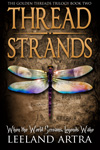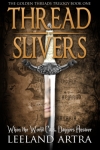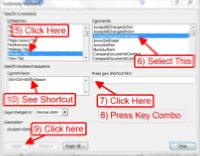 It’s one o-clock in the morning. You have pushed through because you could see the end. Hundreds of hours of work are done and your book is really written. Congratulation you are now an author. All that is left is to watch the sales roll in.
It’s one o-clock in the morning. You have pushed through because you could see the end. Hundreds of hours of work are done and your book is really written. Congratulation you are now an author. All that is left is to watch the sales roll in.
Well, not exactly. There are still a few items to deal with. For example, you have to format the book into an appropriate form for the eBook retailers or print on demand shops. Oh! And there is that silly cover graphic that needs to be made. What about a forward or an epilogue? Do you need an acknowledgements section? Of course, there is the blurb or sales pitch for the back cover.
All of the above can take hours or days, and some talented or determined people manage to work through the various items on their own. Sales might not be fabulous, but a poor blurb, or a unexceptional cover design will not really kill your career.
There is a common mistake that screams, “Hey, this is just a want-to-be writer who isn’t serious.”
What is that mistake? I’ll get to it in a second. First take a step back and consider how many authors you have bought a second, third or fourth book from. Think about the authors who you just know that, if you see their name on a cover, you’re going to drop the cash to buy it and read it with joy. Now, what do they all have in common?
When you have a favorite author you stop looking at the covers, you might only read the blurb to find out if this new fabulous find is part of a series. The blurb and the cover are used to judge new authors that you are not familiar with to see if you’ll give them a shot.
What about authors you’ve decided never to read again. What was it that made you cringe to read the book?
I’ll bet you might not even know why you put some authors on that “never again” list. I know my list had a few I couldn’t identify the reason for until I started writing myself. I went back and analyzed my favorite vs. my “yuck no way” authors.
What was it? It was something I never even noticed, something I am personally horrible at getting right myself.
Okay, enough of the suspense. It was grammar. Yep, a number of authors on my never read again list were there because the first book I got with their name on the cover had some horrible grammar errors. Misused words, and just terrible flow. Good stories, interesting characters, but just unforgivable writing errors.
What is the one mistake that will sabotage your writing career? The answer is not bothering to have a real editor give your manuscript the complete treatment.
The moment I realized this, I knew I would never let that mistake happen. It isn’t easy finding a good editor. They are not exactly inexpensive either, most charging about one cent per word. If your book is one hundred thousand words, that is one thousand dollars in editing services. That is a lot of money to drop. Is it worth it? I’d argue yes. Every single book you sell might bring you a dollar in profit. However, more importantly you want that book to bring you at least one faithful reader. You want to earn the respect of someone so they will buy your next book, and the one after that.
The idiom “you only have one chance to make a good first impression” is true. As an author you will earn back at least ten dollars for every dollar you spend in editing. You will make a good impression, you will make future sales, you will get word of mouth recommendations leading to more of the same.
What if it is impossible for you to hire a professional editor? Well dig in, work hard, find someone qualified. There are librarians, there are high school writing teachers, there are college writing professors, and I know you have friends. Exploit your network of friends and find one or two people that qualify as real editors that will do it for you free.
Be aware of what makes a good editor. Editors do not just correct your typos. They look at the style, the flow, the character development, the tone, and the grammar based on the genre. They do so much more than proofread; you will have to rewrite parts, ditch some stuff, and expand other items based on their feedback.
Editorial passes are not just a one time through the wringer either. My first book had two different editors and went through four revisions before being called done. Even with that, there were still typos and some minor issues. My second book had three professional editors. I sent the book off to one, got it back, worked through the changes and then sent it to the next editor. The book went through each editor three times, which means I did nine revisions. It is almost as much effort as writing the thing. But, the final result shines so brightly I am proud to release it.
Be aware of what each editorial pass is about. Here is the breakdown.
First pass is called the beta read. In a beta read pass the editor is generally ignoring words, grammar and language. This pass is about characters, plot, and flow. The editor is looking for character mistakes, character believability, and plot progress.
Second pass is called a line-edit. In a line-edit pass the editor has the red pen out. All the grammar, word usages, typos, and language are under heavy scrutiny. This pass, the plot and characters are back burner items and it is all about sentence structure, dialogue handling, etc. (This is the pass I dread personally because I’m horribly vicious to the English language.)
Third pass is called a proof read. In a proof read pass, the manuscript is considered “done” and basically ready for print. Most editors can do a proof read in a couple of days. In this pass they are just speed reading the book end to end looking for simple typos. Red pen out, this is generally where some of the stuff you added gets marked up a little. This is also where I get a lot of comments like “had to stop here I was laughing too hard to keep going” and “this is really cute”.
Good editors are busy people. If you want to get onto their schedules you have to book in advance. I have gotten very lucky in finding my editors. I had to do a lot of searching to locate and vet them. You need to find some editors you feel are good for your books. This is not something to short change. Be tough when first meeting an editor. Ask questions like how many books in the [insert genre] realm do you work on? Can you give me references for books you have edited? Do I have to pay for each editorial pass or can we negotiate a one fee for beta+line-edit+proof read type service?
Whatever you do, don’t let your books go out unedited. This is something you can have total control over and there is no need to miss this step. I wish you all the best! Feel free to shoot me questions on Twitter or Facebook.
I wish you all the skill and luck in the world. If you’re another fantasy and/or sci-fi author I’d love to connect with you.
Leeland Artra is a ten month Amazon bestselling author with his debut fantasy/sci-fi trilogy that starts with the book Thread Slivers and is continued in Thread Strands. You can find all of Leeland’s work from his Amazon Author page.

 Originally a guest post for fellow author Jennings Wright (original article at http://bit.ly/1gWyGIE)
Originally a guest post for fellow author Jennings Wright (original article at http://bit.ly/1gWyGIE)







